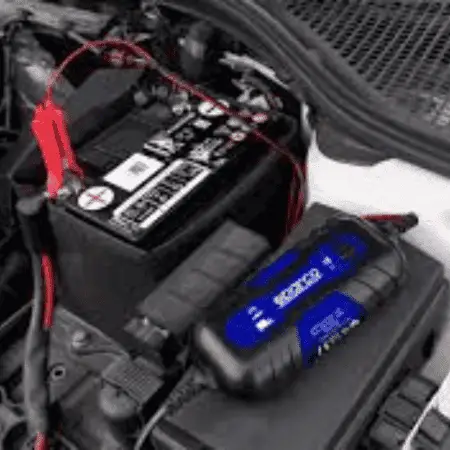The battery voltage serves as the electrical energy source for your vehicle’s various components, including the starter motor, lights, and electronics. A stable voltage is essential for ensuring smooth operation while driving. Driving down the road, you may encounter a sudden drop in your vehicle’s battery voltage, causing various electrical issues. In this article, I will explain why battery voltage drops while driving and what to do. So keep on reading…
Sometimes The battery voltage drops while driving because the car’s electrical system uses power from the battery to run things like lights, radio, and other electronics. This continuous usage gradually drains the battery. To prevent this, you can regularly check your battery’s health and charging system, ensuring they are in good condition. If you notice the voltage dropping too low, it might be time to replace the battery or have the charging system inspected by a mechanic.

Common Causes of Battery Voltage Drops While Driving
Stable voltage levels are vital for optimal performance and longevity of your vehicle’s electrical system. Any significant voltage drop can lead to issues such as dimming lights, difficulty starting the engine, and malfunctioning electronics.
High Electrical Load:
Your car’s electrical system powers various components such as lights, wipers, stereo, and more. Each of these draws power from the battery, and when multiple devices are used simultaneously, it increases the electrical load.
For example, driving at night with the headlights on, the heater running, and the radio playing. All these devices collectively draw a significant amount of power from the battery.
As the electrical load increases, the battery must work harder to meet the demand. This can lead to a drop in voltage as the battery struggles to supply sufficient power to all components.
Aging Battery:
Over time, the internal components of a car battery degrade due to chemical processes and repeated charging cycles. As a result, the battery’s ability to hold a charge diminishes.
A battery that’s been in use for several years may no longer retain as much energy as it did when it was new. This means it may struggle to maintain voltage levels, especially under heavy load.
An aging battery may experience voltage drops more frequently, particularly during periods of increased electrical demand.
Faulty Charging System:
The alternator is responsible for charging the battery while the engine is running. If the alternator malfunctions or fails to operate at full capacity, it can result in insufficient charging of the battery.
A faulty alternator may not generate enough electrical power to replenish the battery’s charge, causing it to gradually lose voltage over time.
A faulty charging system can lead to a gradual decline in battery voltage, especially during extended periods of driving when the battery is not receiving adequate replenishment.
Loose or Corroded Battery Connections:
The battery terminals connect to the vehicle’s electrical system via cables. If these connections become loose, corroded, or damaged, it can impede the flow of electricity.
Corrosion on the battery terminals can create a barrier that inhibits the transfer of electrical current between the battery and the vehicle.
Poor connections increase electrical resistance, causing voltage drops as the battery struggles to deliver power to the vehicle’s components.
Parasitic Drains:
Some electrical components in a car, such as clocks, alarms, and onboard computers, draw power even when the engine is off. These are known as parasitic drains.
A malfunctioning accessory or electrical system component may continue to draw power from the battery even when the vehicle is parked, gradually depleting its charge.
Excessive parasitic drain can lead to a decrease in battery voltage over time, making it more prone to voltage drops during driving.
Extreme Temperatures:
Temperature extremes, both hot and cold, can affect the chemical processes inside the battery. High temperatures can accelerate chemical reactions, while cold temperatures can slow them down.
In hot weather, the electrolyte solution inside the battery may evaporate more quickly, leading to reduced battery capacity. Conversely, cold weather can increase the internal resistance of the battery, making it harder to deliver power.
Extreme temperatures can reduce the overall efficiency of the battery, potentially causing voltage drops during driving, particularly in conditions of temperature stress.
By understanding these detailed factors, you can better diagnose and address issues related to battery voltage drops while driving, ensuring optimal performance and reliability of your vehicle’s electrical system.

You May Find Helpful
- How To Reset Windshield Wiper Fluid Sensor?
- How Do I Stop My Brakes From Squeaking In Reverse? ( 6 Steps )
- Drive Start Control Malfunction – Signs & Causes
- Why Does My RPM Go Up And Down While Parked – 6 Main Causes
what to do when battery voltage drops while driving
When you notice battery voltage drops while driving, here’s what you can do:
- Immediately turn off any non-essential electrical components such as the radio, air conditioning, and interior lights to reduce the load on the battery.
- Pay attention to any dashboard warning lights, especially the battery light or check engine light. If they illuminate, it indicates a problem with the electrical system that needs attention.
- Stop in a safe location and visually inspect the battery terminals and connections for any signs of corrosion, looseness, or damage. Clean and tighten connections if necessary to ensure a secure electrical connection.
- If you have a multimeter, test the battery voltage while the vehicle is running and under load (with accessories turned on).
- Compare the measured voltage to the manufacturer’s specifications to determine if it’s within the normal range. If the voltage is significantly low, it may indicate a failing battery or charging system.
- If you experience symptoms such as engine misfires, loss of power steering or brakes, or the engine stalling, pull over to a safe location as soon as possible.
- Turn off the engine and address any immediate concerns related to safety and vehicle operation.
- If you’re unable to diagnose or resolve the issue on your own, seek assistance from a qualified mechanic or automotive technician.
- They can perform a comprehensive inspection of the electrical system, including the battery, alternator, and related components, to identify and address any underlying problems.
- If the battery is old or showing signs of deterioration, such as reduced capacity or frequent voltage drops, consider replacing it with a new one.
- A new battery can help ensure reliable starting and electrical performance, especially in challenging conditions.
Must Read
- Will Vinegar Damage Car Paint? Potential Risks Of Using Vineger
- How To Fix Open Loop Faults In Cars & Its Causes
- Why Won’t My Car Take Freon? 5 Main Reasons
Conclusion
Maintaining stable battery voltage while driving is essential for ensuring the reliable operation of your vehicle’s electrical system. By understanding the common causes and effects of voltage drops, as well as how to detect and prevent them, you can avoid potentially costly repairs and enjoy a smoother driving experience.
